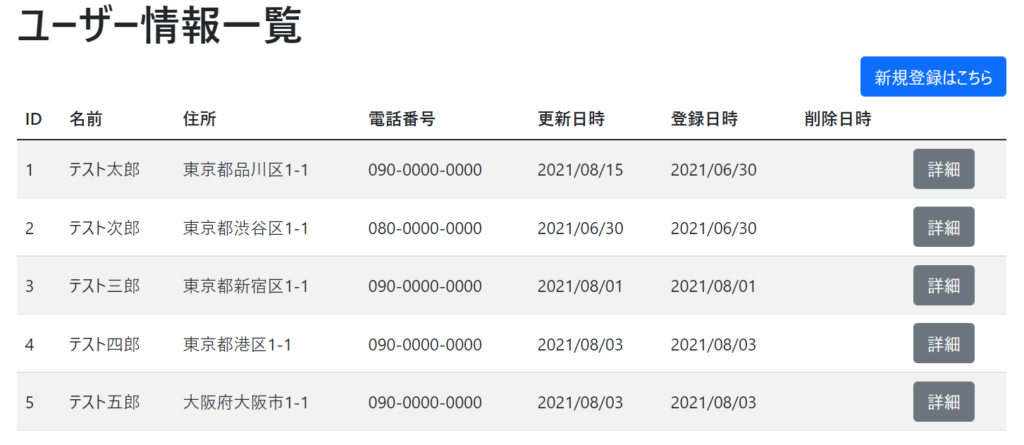目次
はじめに
前回の記事では「Spring Boot」と「Thymeleaf」を使用して詳細画面を作成しました。本記事では詳細画面から「削除」リンクを押下して、対象データを物理削除する方法を紹介します。
※論理削除をするのが一般的ですが、本記事では物理削除しています。
[ユーザー情報一覧画面]

[本記事で作成するユーザー詳細画面]

ユーザー情報一覧画面の「詳細」ボタン押下で、ユーザー詳細画面に遷移。
一覧画面の作成方法はこちら
今回は、ユーザー詳細画面の「削除」ボタンを押下 → 対象データを物理削除 → ユーザー情報一覧画面へ戻るまでの流れを紹介します。
スポンサーリンク
テーブル定義
今回の例で使用するテーブル定義は次のとおり。
[テーブル定義]
| 物理名 | 論理名 | データ型 | NOT NULL | 説明 |
| id | ID | BIGINT | 〇 | 主キー(AUTO_INCREMENT) |
| name | 名前 | VARCHAR(100) | 〇 | ユーザーの名前 |
| address | 住所 | VARCHAR(255) | ユーザーの住所 | |
| phone | 電話番号 | VARCHAR(50) | ユーザーの電話番号 | |
| update_date | 更新日時 | DATETIME | 〇 | 最終更新日時 |
| create_date | 作成日時 | DATETIME | 〇 | 登録日時 |
| delete_date | 削除日時 | DATETIME | 論理削除した日時 |
開発環境
開発環境は以下のとおり。
| 開発環境 | 名称 | 説明 |
| 開発言語 | Java | 人気の開発言語 |
| 開発ツール | Eclipse | Javaでの定番開発ツール |
| フレームワーク | Spring Boot | 人気のSpringフレームワークをベースとしたフレームワーク |
| テンプレートエンジン | Thymeleaf | Spring Bootと相性が良いテンプレートエンジン |
| データベース | MySQL | フリーで利用できる人気データベース |
その他 データベースへの接続は「Spring Data JPA」、画面のデザインには「Bootstrap」を使用しています。
ディレクトリ構成
ディレクトリ構成は次のとおり。
springSample
|
|___src.main.java
|
|___com.example.demo
| |
| |___controller
| | |
| | |__UserController.java
| |
| |___entity
| | |
| | |___User.java
| |
| |___repository
| | |
| | |___UserRepository.java
| |
| |___service
| |
| |___UserService.java
|
|___src.main.resources
|
|___templates
| |
| |___common
| | |
| | |___head.html
| |
| |___user
| |
| |___add.html
| |
| |___list.html
| |
| |___view.html
|
|___application.propertiesバックエンド(サーバー)側のソースコード
コントローラークラス(UserController.java)
コントローラクラスの内容は以下のとおり。
package com.example.demo.controller;
import java.util.List;
import org.springframework.beans.factory.annotation.Autowired;
import org.springframework.stereotype.Controller;
import org.springframework.ui.Model;
import org.springframework.web.bind.annotation.GetMapping;
import org.springframework.web.bind.annotation.PathVariable;
import com.example.demo.entity.User;
import com.example.demo.service.UserService;
/**
* ユーザー情報 Controller
*/
@Controller
public class UserController {
/**
* ユーザー情報 Service
*/
@Autowired
private UserService userService;
/**
* ユーザー情報一覧画面を表示
* @param model Model
* @return ユーザー情報一覧画面
*/
@GetMapping(value = "/user/list")
public String displayList(Model model) {
List<User> userlist = userService.searchAll();
model.addAttribute("userlist", userlist);
return "user/list";
}
/**
* ユーザー新規登録画面を表示
* @param model Model
* @return ユーザー情報一覧画面
*/
@GetMapping(value = "/user/add")
public String displayAdd(Model model) {
return "user/add";
}
/**
* ユーザー情報詳細画面を表示
* @param id 表示するユーザーID
* @param model Model
* @return ユーザー情報詳細画面
*/
@GetMapping("/user/{id}")
public String displayView(@PathVariable Long id, Model model) {
User user = userService.findById(id);
model.addAttribute("userData", user);
return "user/view";
}
/**
* ユーザー情報削除
* @param id 表示するユーザーID
* @param model Model
* @return ユーザー情報詳細画面
*/
@GetMapping("/user/{id}/delete")
public String delete(@PathVariable Long id, Model model) {
// ユーザー情報の削除
userService.delete(id);
return "redirect:/user/list";
}
}ユーザー情報の削除は「delete」メソッドで実装。サービスクラスを呼び出し物理削除後、ユーザー情報一覧画面へリダイレクトしています。
ユーザー情報一覧画面へリダイレクトすると「displayList」メソッドが呼ばれます。「displayList」メソッドでは、一覧に表示する最新データを取得しています。
サービスクラス(UserService.java)
サービスクラスの内容は以下のとおり。
package com.example.demo.service;
import java.util.List;
import org.springframework.beans.factory.annotation.Autowired;
import org.springframework.stereotype.Service;
import com.example.demo.entity.User;
import com.example.demo.repository.UserRepository;
/**
* ユーザー情報 Service
*/
@Service
public class UserService {
/**
* ユーザー情報 Repository
*/
@Autowired
private UserRepository userRepository;
/**
* ユーザー情報 全検索
* @return 検索結果
*/
public List<User> searchAll() {
return userRepository.findAll();
}
/**
* ユーザー情報 主キー検索
* @return 検索結果
*/
public User findById(Long id) {
return userRepository.findById(id).get();
}
/**
* ユーザー情報 物理削除
* @param id ユーザーID
*/
public void delete(Long id) {
User user = findById(id);
userRepository.delete(user);
}
}JPAが提供している「findById」で対象データを抽出後、「delete」関数を使用してユーザー情報を物理削除しています。
エンティティクラス(User.java)
データベースから取得したデータを格納するエンティティクラスの内容は以下のとおり。「@Data」アノテーションを使用して、getter、setterの定義を省略しています。
package com.example.demo.entity;
import java.io.Serializable;
import java.util.Date;
import javax.persistence.Column;
import javax.persistence.Entity;
import javax.persistence.GeneratedValue;
import javax.persistence.GenerationType;
import javax.persistence.Id;
import javax.persistence.Table;
import lombok.Data;
/**
* ユーザー情報 Entity
*/
@Entity
@Data
@Table(name = "user")
public class User implements Serializable {
/**
* ID
*/
@Id
@Column(name = "id")
@GeneratedValue(strategy = GenerationType.IDENTITY)
private Long id;
/**
* 名前
*/
@Column(name = "name")
private String name;
/**
* 住所
*/
@Column(name = "address")
private String address;
/**
* 電話番号
*/
@Column(name = "phone")
private String phone;
/**
* 更新日時
*/
@Column(name = "update_date")
private Date updateDate;
/**
* 登録日時
*/
@Column(name = "create_date")
private Date createDate;
/**
* 削除日時
*/
@Column(name = "delete_date")
private Date deleteDate;
}リポジトリクラス(UserRepository.java)
データベースにアクセスする為のリポジトリクラスの内容は以下のとおり。
package com.example.demo.repository;
import org.springframework.data.jpa.repository.JpaRepository;
import org.springframework.stereotype.Repository;
import com.example.demo.entity.User;
/**
* ユーザー情報 Repository
*/
@Repository
public interface UserRepository extends JpaRepository<User, Long> {}フロントエンド(クライアント)側のソースコード
スポンサーリンク
ユーザー情報詳細画面(view.html)
共通ヘッダ(head.html)、ユーザー情報一覧画面(list.html)のHTMLは一覧画面作成の記事で紹介していますので、そちらの記事をご覧ください。
一覧画面作成の記事はこちら
ユーザー情報詳細のHTMLは以下のとおり。画面のデザインにはBootstrapを使用しています。
<!DOCTYPE html>
<html xmlns="http://www.w3.org/1999/xhtml"
xmlns:th="http://www.thymeleaf.org">
<head
th:replace="common/head :: head_fragment(title = 'ユーザー情報詳細', scripts = ~{::script}, links = ~{::link})"></head>
<body>
<div class="container">
<h1>ユーザー情報詳細</h1>
<div th:object="${userData}">
<div class="row mx-md-n5">
<div class="col-2 pt-3 border bg-light">名前</div>
<div class="col pt-3 border">
<p th:text="*{name}"></p>
</div>
</div>
<div class="row mx-md-n5">
<div class="col-2 pt-3 border bg-light">住所</div>
<div class="col pt-3 border">
<p th:text="*{address}"></p>
</div>
</div>
<div class="row mx-md-n5">
<div class="col-2 pt-3 border bg-light">電話番号</div>
<div class="col pt-3 border">
<p th:text="*{phone}"></p>
</div>
</div>
</div>
<br />
<div class="text-center">
<a th:href="@{/user/{id}/edit(id=*{id})}" class="btn btn-primary disabled" aria-disabled="true"> 編集 </a>
<a th:href="@{/user/{id}/delete(id=*{id})}" class="btn btn-secondary"> 削除 </a>
<a href="/user/list" class="btn btn-secondary">一覧に戻る</a>
</div>
</div>
</body>
</html>動作確認
Spring Bootプロジェクトを実行して http://localhost:8080/user/list へアクセスします。

ユーザー情報一覧画面が表示されるので、一覧から対象ユーザーの「詳細」ボタンを押下します。

ユーザー情報詳細画面が表示されるので「削除」ボタンを押下するとユーザー情報一覧画面へ戻ります。削除したデータがユーザー情報一覧画面に表示されていなければ完了です。
